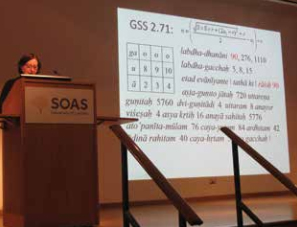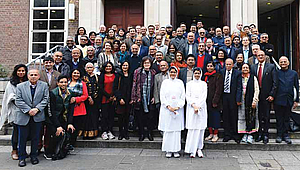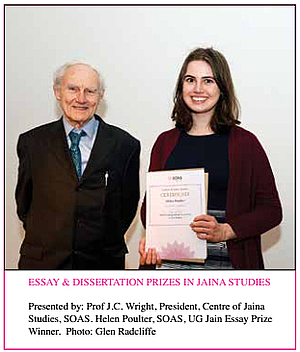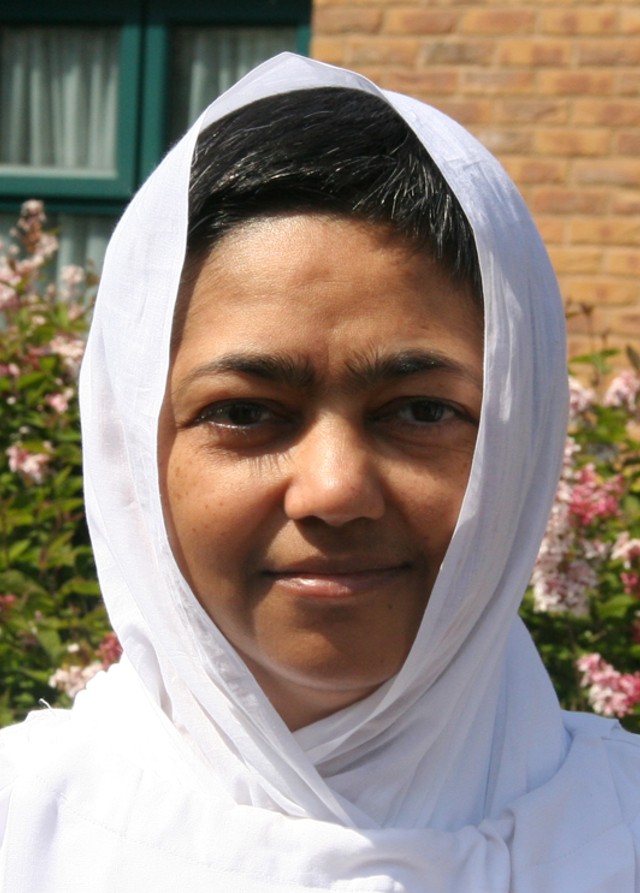
Centre of Jaina Studies Newsletter: SOAS - University of London
The Workshop was organized by the CoJS in collaboration with the Gyansagar Foundation, based in New Delhi.[1] Professor Anupam Jain from the Government Degree College in Indore opened the proceedings with the 16th Annual Jaina Lecture at SOAS on Newly Discovered Jaina Mathematical Manuscripts. He started with a reference from Mahāvīrācārya's Gaṇitasāra Saṃgraha 1/16: 'Whatever there is in all three worlds, comprising moving and non-moving beings, all that indeed cannot exist as apart from mathematics'. The renowned historian of Indian mathematics B.B. Datta first used the term 'Jaina School of Mathematics' in his publication of 1929. Jaina ācāryas wrote texts of a high mathematical content, many of which are still unknown to the academic world. A. Jain provided an extensive survey conducted during thirty-five years of researching in numerous Jaina libraries to discover texts dedicated to mathematics (including astronomy). He gave an overview of the published non-canonical Jaina mathematical literature and unpublished manuscripts as well.
Jain discussed the Triśatikā manuscript, available in the British Library, also published by S.D. Dwivedi in 1899 and by Sudyumna Acharya in 2004 with the Sumedhā commentary.
Jain also reviewed the Jyotirjñānavidhi of Śrīdharācārya, which is crucial for finding the auspicious time through astrological analysis. He discussed the contrasts to the Hindu astrological method of choosing the lunar day. Further he discussed the Ṣaṭatriṃśikā or Ṣaṭatriṃśatikā of Mādhavacandra Traividya (11th century CE). With regard to the Uttarachattīsī Ṭīkā of Gaṇitasāra, Jain presented the logical rationale for providing the formulae x/0=x which is otherwise denied in mathematics. He also discussed other manuscripts: Lokānuyoga by Jinasena I (783 CE), Trailokyadīpaka of Pt. Vāmadeva (14th c. CE), Trilokadarpaṇa of Kavi Khadagasena (1656 CE), and Gaṇitasāra of Hemarāja (17th century CE). Finally, he emphasized the necessity of gathering copies of such manuscripts from the bhaṇḍāras, digitizing and make them accessible for further research, thus bringing to light the Jaina mathematical contributions.
The papers of the next day seemed to validate Mahāvīrācārya's declaration that mathematics is 'an intrinsic part of Jaina reality'. The diverse presentations ranged from fields such as metaphysics, human science (physiognomy), astronomy, numbers, architecture, arithmetic, geometry, time, etc.
In the first panel, 'Evidence and Proof in Jaina Science & Philosophy', Muni Mahendra Kumar from the Jain Vishva Bharati Institute, presenting via Skype, discussed The Enigma of the Cosmogony, with reference to his recent book of the same title. According to the Jain canonical texts, the universe (the cosmos) is beginningless with respect to time. In modern scientific cosmogony, several hypotheses articulating similar alternatives to the 'big bang theory" are proposed by scientist such as J.V Narlikar, Saurya Das, Fred Hoyle, Hermann Bondy and Thomas Gold, who proposed the theory of the "steady state universe'. Muniśrī discussed Jaina cosmogony as an eternal interplay of intangible and tangible realities. He then discussed the mode of interaction, the causal factors of the disparity.

Ratnakumar Shah (Pune)
Following this, Marie-Hélène Gorisse (SOAS & Ghent University, Belgium) considering the role of Scientific Knowledge in Jainism, specifically discussed induction. She analysed commentaries of the Tattvārthasūtra by Siddhasena and Akalaṅka. Articulating the characteristics of scientific knowledge as propositional knowledge, she discussed problems in terms of Bertrand Russell's refutation of induction, David Hume's theory of 'universality of nature being requisite for faith' etc., and Karl Popper's attempt to redefine science 'as a method for solving problems' based on the process of falsification. Hence, metaphysical and religious claims being non-falsifiable truths, will be tagged as 'nonscientific'. Gorisse then compared Jainist propositions to Kantian apriori conditions, which are non-falsifiable as well. Comparing Dignāga's three conditions as a proof of induction with Jainas 'invariable concomitance' (anyathā-anupapatti), being only possible condition for induction, she argued that the postulation of a necessary relation between the universal and the particular in Jainism, allows them to survive with one condition. Yet, she concluded that though it seems a solution for Jaina philosophy, it only shifts the problem to a higher level, raising a question whether anyathā-anupapatti is the only unconditional condition for induction.
Ana Bajelj (Postdoctoral Polonsky Academy, The Van Leer Jerusalem Institute, Israel) then focused on the development of concepts as an attempt to scientize reality. Her paper, Upakāra in Akalaṅka's Tattvārthavārtika, discussed a passage of the Tattvārthasūtra (TS5.1722) detailing the various kinds of assistance (upakāra) provided by the six basic substances. Comparing Pūjyapāda's Sarvārthasiddhi with the Rājavārtika of Akalaṅka, she traced the influences of the former on the later. Akalaṅka emphasizes that the assisting functions of substances are unique to themselves and can never lose their inherent capacities even in the absence of the recipients. Bajelj argued that the Jaina doctrine of causality developed as part of a 'scientific' endeavor to systematically and rationally explain the nature of reality. Presenting the influential conceptual development of upakāra she emphasized the metaphysical implications rather than mere empirical significance of assistance.
The second panel dwelled on the 'Jaina Theories of Time'. On behalf of Rājmal Jain (Kadi Sarva Vishvavidyalay, Ahmedabad), who was unable to attend in person, Anupam Jain presented the paper, Space and Time: In the Perspectives of Jainism and Science. It was an attempt to attribute scientific significance to several Jaina concepts such as the values of six Jaina eons (kāla cakra), yojana (a traditional measure), distance and zodiacal extensions of sun, moon, stars, etc. The paper attempted to define vyavahāra-kāla (empirical time) as the function and energy of niścayakāla (transcendental time), and further dealt with critical issues such as relationship between the concepts numerable (saṃkhyāta), innumerable (asaṃkhyāta), and infinite (ananta), and the significance of the number 84. His discussion of the equivalence of the space unit (pradeśa) with the time unit (samaya) was based on the Tiloyapannatti of Yativṛṣabha (2nd century CE). Overall, it was a mathematical presentation of the conceptual philosophical ideas, advocating for more research.
Samani Unnata Pragya (SOAS, Jain Vishva Bharat Institute, Ladnun) then argued that Jaina concepts are not always grounded in mathematics, and at times are beyond measurements. In her paper Jain Theory of Timelessness she investigated the theory of timelessness (śūnya-kāla) based on Jaina metaphysics and epistemology. Time as per Anuogadārāiṃ is both existential reality and a measurement. The unit of time (samaya) therefore has a dual role of being transcendental and an empirical unit of measurable time. She researched dispersed textual references of timelessness related to both aspects of time. She illustrated with examples three kinds of timelessness analysed from different aspects drawn from Bhagavaī, Pannavaṇā, Pañcāstikāya, etc. Firstly, 'immeasurabletimelessness' originates due to epistemological issues as observed in aspriśada gati (a journey in space without touching the intermediate space units) where the intermediate point of the journey is not cognizable. Secondly, 'beyond time measure' are the intrinsic modes (artha paryāya) which exist in the now with the dynamism of change, a metaphysical state. Finally, 'existence without time' in supra-cosmos, is relatively acknowledged, for nothing but space exists outside cosmos. Hence, she argued, though zero time is absent in the Jaina lists of time values, the Jaina conceptualization of the intrinsic nature of reality and cognition by default cannot go without the presupposition of the notion of timelessness.

Cathérine Morice-Singh (Paris)
The next paper by Cathérine Morice-Singh (Université Sorbonne NouvelleParis 3) was about The Treatment of Series in the Gaṇitasārasaṃgraha of Mahāvīrācārya and its Connections to Jaina Cosmology. The Gaṇitasārasaṃgraha of Mahāvīrācārya (9th century CE) teaches the addition and subtraction of series, presenting arithmetic and geometric progression. His arithmetic progression is an amplified version of what Āryabhaṭa and Brahmagupta had already discussed under the designation śreḍhī vyavahāra. Morice-Singh presented various mathematical terms, such as stride (gaccha), step (pada), value of the accumulation for the common difference (uttara-dhana), value of all (sarva-dhana), value of the accumulation for the first term (ādi-dhana), etc., and convenient methods for difficult problems. Then, relating this to Jaina cosmography, she presented examples of arithmetic progressions for the mathematical description of loka, hell, etc. and the formulae to calculate the holes, widths, the heights of the holes, etc., of hell. Using formulas from geometric progression, she explored calculations of different cosmological areas, such as the innumerable islands and oceans found in madhya loka, and further the differently arranged hellish holes, etc. She concluded that the computation of series receives a special place in the GSS because they play a great role in Jaina cosmographical calculations.
The third panel on 'Jaina Mathematicians' started with Ratnakumar Shah's (Pune) paper on Jinabhadragaṇi Kṣamāśramaṇa: Computational Wizard of Sixth Century C.E., which rendered light on the mathematical work of the great Jaina saint-scholar, a close contemporary of Āryabhaṭa I. In Shah's view he employed almost modern methods of arithmetical processes, such as using a decimal system with zero having place value, showing great proficiency in dealing with big numbers addition, subtraction, multiplication, division, extraction of square roots, operations with fractions, mensuration of triangle, trapezium, circle, and use of rule of three, etc. Although in his works Bṛhatkṣetrasamāsa, Bṛhatsangrahaṇi, and Viśeṣāvaśyakabhāṣya numbers are expressed in words and no symbols for numerals appear therein. He argued that in the processes described, numbers uttered digitwise and calculations involving very large numbers leave not an iota of doubt that some conception of zero was existing by then. Shah also rendered examples from JB's work such as square roots of large numbers, formula for the area between two parallel chords of a circle, area and volume of the Lavaṇa sea, etc. He argued that it corresponded to the pre-calculus method of indivisibles adopted by Cavalieri and Roberval in the 17th c. CE. Even elements of the modern modular arithmetic could be traced in his works. Jinabhadra's work presented not only the earliest use of zero place value in decimal system and symbols for 10 digits (0 to 9), his precision and ease with such big numbers rightly marks him a computational wizard of his era.
Since the announced next presenter Alessandra Petrocchi (University of Cambridge, UK) was unable to attend and present her paper on Siṃhatilakasūri's Mathematical Commentary (13th c. CE) on the Gaṇitatilaka, we had a presentation by L. C. Jain (Government Engineering College, Jabalpur) on Non-Absolutism (Anekānta) and Modern Physics, a paper which discussed anekānta and its posited close association with physics.
The last paper of this panel by Johannes Bronkhorst (University of Lausanne, Switzerland) Jaina versus Brahmanical Mathematicians, took a different approach of analysing the critique of Brahmanical mathematicians of their heterodox tradition. He primarily demonstrated that Bhāskara I's Āryabhaṭīya-bhāṣya (7th century CE) on geometrical theorems survived with errors as they lacked proof of it. Bronkhorst then presented a rare passage in the Āryabhaṭīya-bhāṣya which reveals an implicit criticism presented in Pāli language presumably addressed to the Jainas, as Buddhists were silent in this field. His research revealed that though the formulae of π rendered by the Jainas, which was critiqued by Bhāskara, have an error, Bhāskara's refutation is flawed as well. Debate arose in the context of the calculation of the length of the arch of a circle. Bhāskara argued that, if the π value of the Jainist is used, the calculation does not yield correct results. But Bronkhorst's research showed that the prediction of Bhāskara finding fault in the π value was illogical as even with his π value the problem persisted, which meant that the error was not mainly about the π value of the Jaina but the formulae. Concluding, Bronkhorst suggested that the geometry practiced at the time of Bhāskara I in different schools concentrated on their own traditional teachings. If these traditional teachings were incorrect, they were preserved for lack of criticism. Criticism of different schools confronting each other, were unfortunately too infrequent, and did not allow a general atmosphere of criticism to become part of the traditions.[2]
The first paper of the last session 'When Science Meets Fiction', Architectural Science in Jain Poetry: Descriptions of Kumārapāla's Temples was delivered by Basile Leclère, (Université de Lyon 3, France). The Caulukya king Kumārapāla (r. 1143-73), influenced and converted by the Śvetāmbara monk Hemacandra, ordered Jaina sanctuaries to be erected throughout his dominion. He was duly praised by Hemacandra in the concluding section of the Triṣaṣṭiśalākāpuruṣa-caritra. Many other Jaina writers from the twelfth and thirteenth centuries extolled Kumārapāla as a great builder. Basile Leclère researched these temples assisted by contemporary texts such as Mahārājāparājayā, etc. Discussing the difficulties of terminology, he cautioned that terms used in the chosen guidebook might be anachronistic to the work being compared. He analysed texts such as Mahāvirā's composition Kumāra Vihāra Praśasti, Kumāra Vihāra Śatakā by Rāmacandra, and Somaprabhā's poem Kumārapāla-pratibodha, and presented examples to prove their expertise and precision in the use of architectural terms. He concluded that these texts instead of merely detailing the idols, extol the technical expertise of architecture, and hence must be taken more seriously for analysing Jaina sacred architecture.

In her paper When Science Meets Fiction: On Technical Passages in Jain Medieval Novels, Christine Chojnacki (University Lyon) presented further research on a novel subject: physiognomy, a study of a person's facial or at times bodily features or expressions, especially when regarded as indicative of character or ethnic origin. The earliest research in this field was by K. G Zysk on Hindu materials. Chojnacki's research in Jainism identified four types of relevant sources: the Garga Saṃhitā (1 CE) an astrological text, Varamihirā's Vṛhad Saṃhitā (6 CE), one of the earliest extant systematically presented texts, a compendium titled Samudrikā Śāstra by King Dolavarāja and his son Jagadeva, and the Purāṇa texts. First, she discussed problems of tracing the historical development of Jaina physiognomy, beginning with the dating of texts such as the Purāṇas A great deal of variation in the description of body parts, numerological details of symbols on the body, etc., exists in the sources. She then compared three long narratives: Udyotanā's Valayamalā (Pkt.) (1779 CE), Siddhārṣī's Upamiti Bhāvaprapañca Kathā (Skt.) (905 CE), and Vijayasiṃṃhasūrī's Bhuvanasundari (Pkt.) (918 CE). Finally, relating to Jaina religion, she discussed the great men (śalākhā puruṣa), descriptions of the deity Padmāvatī, etc. She concluded that Jaina monks had produced treatises on physiognomy from the 6th to 11th centuries CE and that Udyotanā and Siddhārṣī's had access to sources prior to Varahamihira.
Peter Flügel withdrew his announced paper on Jainism and Science: History and Ontology of the 'Soul' to accommodate in the program Hampasandra Nagarajaiah to present his research on Pacchakkhāna Leading to Sallehaṇā, which seemed to be relevant at this time when the Jaina community is facing a related court case against it in India. In his paper Nagarajaiah discussed in detail the definitions, methods and antiquity of the practice.

The conference concluded with a round table discussion, which was chaired by Shamil Chandaria (London). The other panelists were Johannes Bronkhorst, Kalyan Gangwal (Pune), Anupam Jain, Laxmi Chandra Jain (Government Engineering College, Jabalpur), Mukul Shah (London), Ratnakumar Shah, Sanjeev Sogani (Gyan Sagar Science Foundation, New Delhi), and Samani Unnata Pragya.
While there was general consensus about Jaina mathematics, physics, atomic theory, etc. being compatible with scientific theories, there were some words of caution that the terms and concepts used by both need to be intensively investigated before making claims of similarity. The panel concluded with Prof. Bronkhorst's pragmatic and prudent statement that the comparison between science and religion might not lead to any new truth.
Samaṇī Unnataprajñā is a PhD student at SOAS.

Roundtable on the question 'Is Jaina philosophy compatible with the modern sciences?
 Samani Unnata Pragya
Samani Unnata Pragya